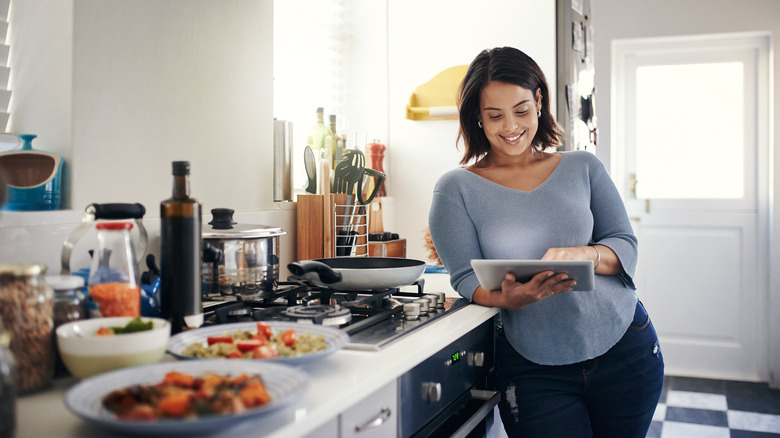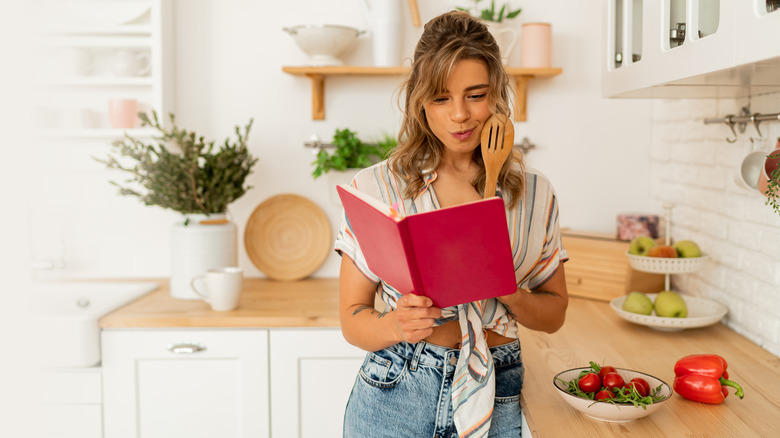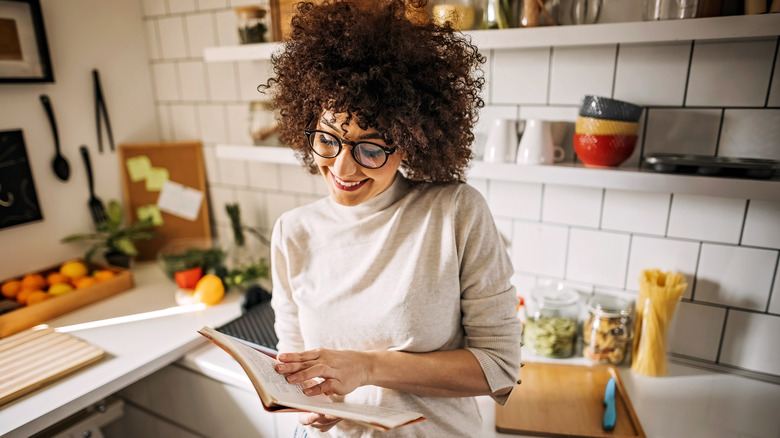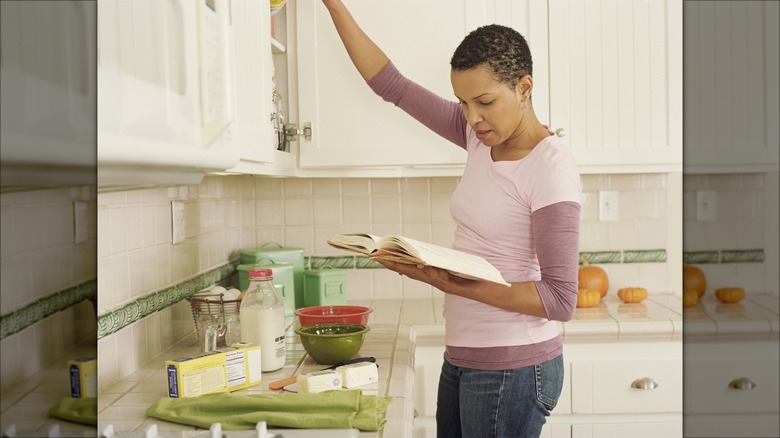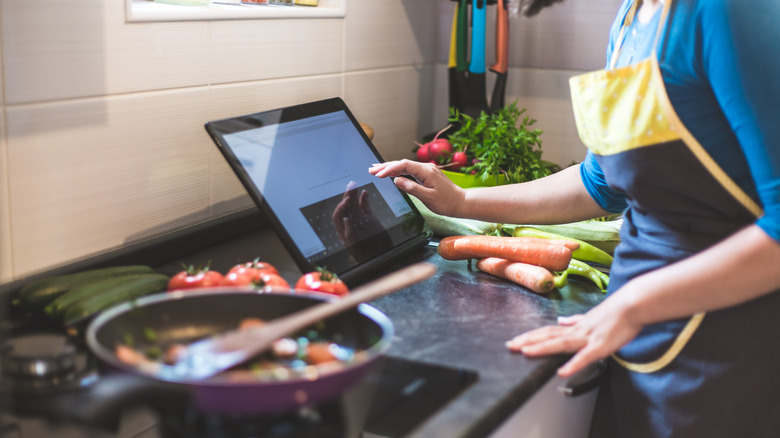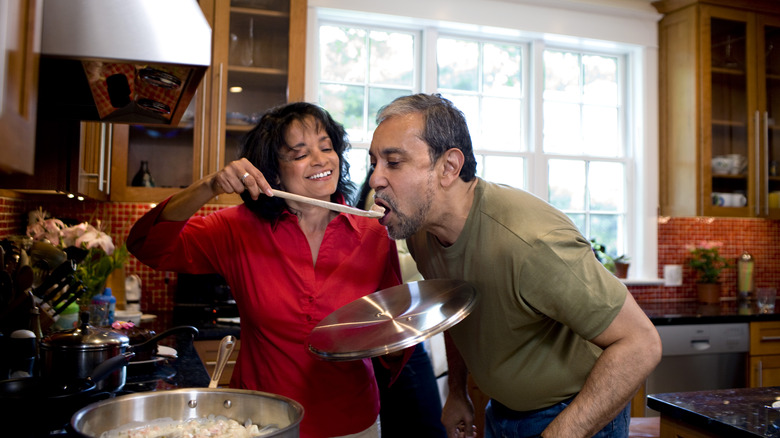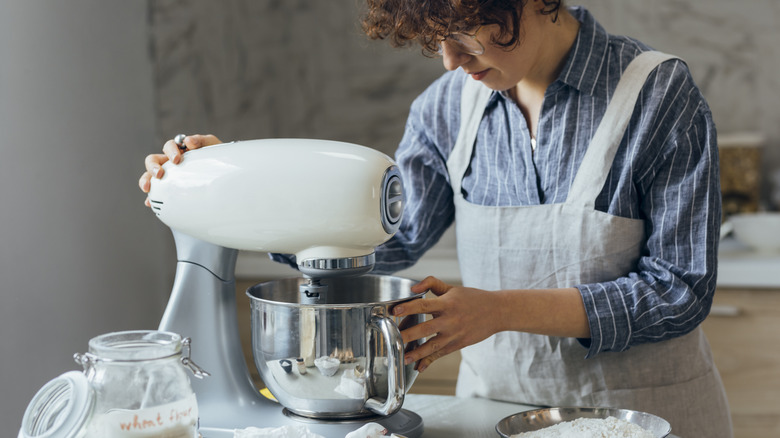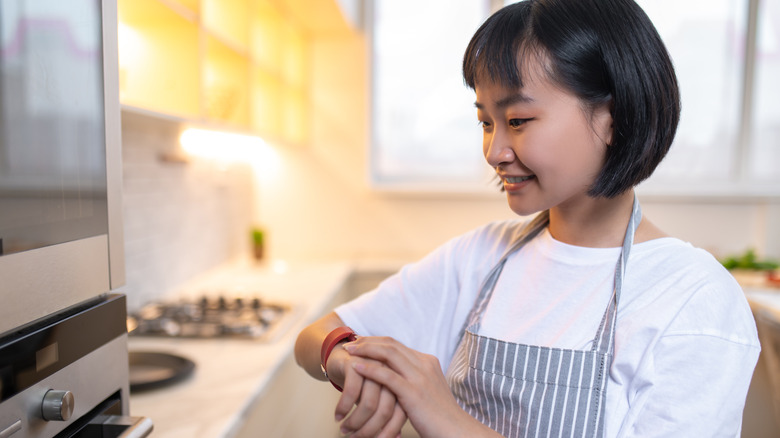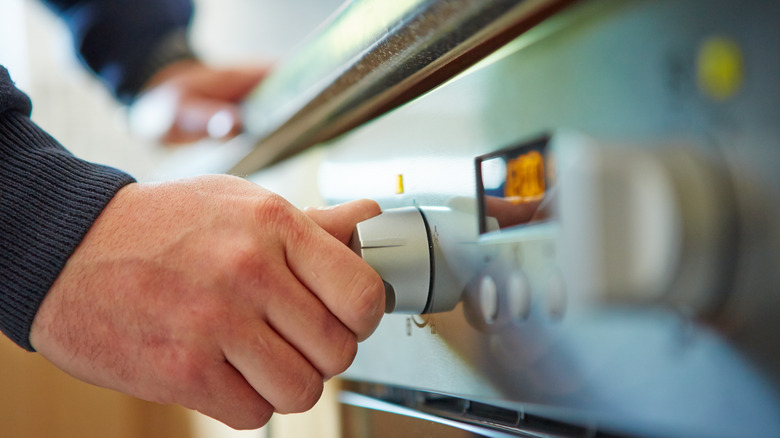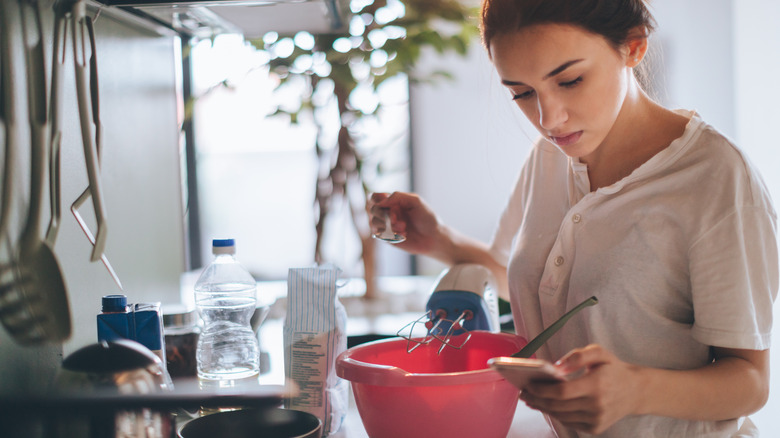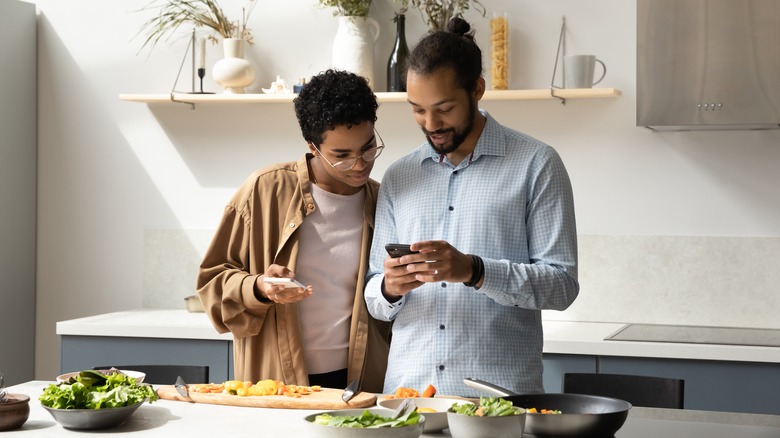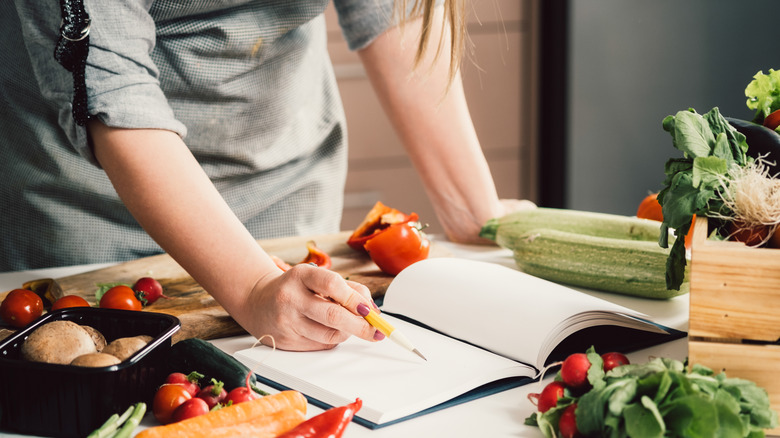12 Mistakes You Should Avoid Making When Reading A Recipe
Whether you love cooking or baking or only spend time in the kitchen because you have to make food for yourself or others to eat, chances are you've followed several recipes over the years. Finding a new recipe to try — whether from an online resource or a physical cookbook — can be exciting. When all the ingredients sound like they'll combine together to make something that tastes incredible, you often can't wait to give it a try.
However, before you start ransacking your pantry for the needed ingredients or running to the grocery store, you're going to want to take a small step back for a moment. There are several mistakes that people commonly make when reading and preparing a recipe. Unless you want that recipe you were so excited about not to turn out as expected; you'll want to keep reading so you can learn how to avoid these potential mistakes.
Not reading through the entire recipe before you plan to make it
One of the biggest mistakes people make when preparing a recipe is not reading through the recipe ahead of time. And, no, this doesn't mean printing it out or pulling it up on your phone or tablet 15 or 20 minutes before you plan on making it. Rather, you should read through the entire recipe — yes, all of it — before you even finalize your decision to make it and definitely before you put together your shopping list.
There is almost always important information in the recipe steps that you'll need to prepare properly and that you won't find just by looking at the ingredient list. For example, some recipes require the batter or various ingredients to chill for several minutes, hours, or even overnight. If you don't read the recipe ahead of time, you won't leave time for this crucial step and won't be able to prepare the dish as planned. Another reason to read the entire recipe ahead of time is to get a general idea of what you'll be doing with each ingredient to help you make the right selections at the grocery store. For example, if you need to slice the mushrooms, purchase a package already sliced to minimize your prep work.
Not having a copy of the recipe easily accessible as you work
Another mistake people often make when following a recipe is not planning ahead to have a copy of the recipe handy when they're cooking. Trying to remember all of the ingredients and steps for a new recipe is, well, a recipe for disaster. And, while you may be able to pull up a copy of the recipe on your phone, it will be a nuisance to have to keep washing your hands to touch your phone and/or re-entering your password when your screen times out. Even if the recipe you're following is from a physical cookbook, do you really want to worry about getting the cookbook all dirty with the various ingredients?
Instead, have a copied or printed version of the recipe available to reference when you cook. This way, you won't need to worry about getting it dirty or logging back into your phone to check the next step. Once you've finished cooking, if the paper copy is a mess, you can simply put it in the trash or recycling bin.
Not having all the necessary tools and ingredients ready
When you're making something new or trying to get a meal on the table as quickly as possible, it is easy to jump right in and start following the directions for the recipe you're preparing. However, rushing to get started is never a good idea. Before you actually start following any of the directions, you need to make sure that you have all of the ingredients and tools that you'll need ready.
Once you start cooking, stepping away from the stove to grab other ingredients or dig through your cabinets or drawers looking for a particular tool gets more challenging. Taking a few minutes before you start cooking to lay out everything you'll need can make such a difference and make the actual process of cooking the meal less stressful. Pre-measuring ingredients can make things even easier. Plus, if you happen to be missing an ingredient, you can run out to grab it. If you're already in the middle of cooking, it is going to be much more difficult to get to the store without messing up what is in the process of being cooked.
Not researching vocabulary and techniques that you aren't familiar with
Some recipes that you want to try may include specific techniques or culinary terms that you're not familiar with. Flambé, en papillote, au gratin, tenderize, dredge, caramelize, mince, al dente, blanch, deglaze, parboil, sear. These are just a few of the more specific culinary terms that you might find in a recipe you're preparing. And, if you don't know what most of them mean, you're not alone. Many of these are very specific terms that certainly aren't used in everyday conversation. However, if you're making a recipe that calls for one of them, you'll need to know what to do.
Don't wait until you're in the kitchen and in the middle of following the recipe to perform a Google search. Instead, take a few minutes to do some research before you plan to start preparing the recipe. This will make sure that you're prepared and have the knowledge you need to successfully execute the technique.
Making substitutions and assuming the dish will turn out the same
When preparing a recipe, it is important to follow the ingredient list and directions exactly the way they are presented. Otherwise, you're taking the risk that the recipe may not turn out as desired. Coming up with a recipe often involves a lot of trial and error on the part of its author. The specific ingredients are known to work well together and yield a tasty finished product with the right texture. Messing with them and substituting something else — even if it doesn't feel like it could impact things — can be a mistake.
For example, light brown sugar and dark brown sugar are different. Substituting one in place of the other will change the flavor of the finished recipe. Dairy-free ingredients don't always act the same as their cow's milk counterparts, so trying to replace shredded cheese with a dairy-free option may not deliver the results you expect (in this case, you may be better off searching for a different recipe that is already dairy-free). The first time you make a recipe is when it will be the most important to follow it to a T. After you've made it at least once, you should have a better idea of how everything comes together, and then you might be able to experiment with a few small substitutions.
Mixing ingredients in a different order than what is specified
Just as it is important not to mess with the list of ingredients, it is equally important to closely follow the order in which those various ingredients are supposed to be combined. Again, the chef who wrote the recipe likely spent a lot of time experimenting with different combinations of ingredients and adding them to the bowl or pot. The order that is presented in the recipe is the result of all of this hard work, so why make changes to it that could impact how your dish turns out?
When it comes to baking, specifically, recipes often call for combining all of the wet ingredients in one bowl and the dry ingredients in another before mixing everything separately. This is a crucial step that you don't want to skip. If you don't mix the dry ingredients before adding in the wet ingredients, it is more likely that various dry ingredients — such as baking soda or salt — won't be evenly distributed in the finished batter. Or, you'll end up over-mixing everything, trying to get the various ingredients well incorporated. As you can probably guess, both of these can impact how well the item bakes or ends up tasting. Just take a few extra minutes and get a few additional dishes dirty to make sure you follow the recipe instructions as they're written.
Strictly following the cooking or baking time
The directions for most recipes tell you how long to cook or bake whatever you're preparing. While this can be very helpful, you should use it as more of a guide than a strict rule. Food items may cook differently in your oven or on your stovetop than they did when the recipe's author was testing it. Ovens are notoriously inaccurate, and even a temperature difference of a few degrees could cause your roast or cookies to bake faster or take longer than the suggested time in the recipe.
Another reason to use these times as a guideline comes down to personal preferences. For some items, such as pasta, you may have different opinions about how firm or soft you like it. This may make it necessary to add or subtract a few minutes from the cooking time. The bottom line is that it is very important to monitor the progress of the foods you're cooking to know when they're going to be done. This will be especially important the first time you try a new recipe. Be sure to use a meat thermometer for chicken, steak, fish, and other meats to make sure they are cooked to a safe internal temperature.
Not planning for enough time to prep and cook the dish
Another mistake that you'll want to avoid when preparing a recipe is failing to leave yourself enough time to prepare and cook or bake the dish. Again, the recipe itself can often be a good starting point for deciding how long it will take you to make. Most recipes include an estimated prep time and cook/bake time. However, these numbers will not always be accurate.
When you're making something for the first time, it might take you longer to follow the steps outlined in the recipe. As shared above, the stated cook time might end up being inaccurate, and it could take your dish several additional minutes to finish cooking. Because of these variables and the potential for something else to interrupt you when cooking (a phone call, kids who need help, etc.), it is always a good idea to leave some extra time. Begin by determining what time you want to have the meal ready to eat and work back from there. Don't forget to leave time for roasts and other dishes to rest, if necessary.
Forgetting to preheat the oven — or intentionally skipping the preheating process
One thing that can really throw off your timing is forgetting to preheat the oven. If you have the recipe ready to go and realize that your oven isn't hot, it will be very frustrating. Deciding just to put the recipe into a cold oven (or intentionally skipping the preheating process in the first place) is not a good alternative.
There is a reason most recipes — particularly those for baked goods — call for placing the dish into a preheated oven. When the oven isn't hot, the foods you're baking aren't going to turn out right. For example, if you place your cookies into a cold oven, they're going to spread over the baking dish. Instead of nice circles, you'll end up with a very thin and oddly-shaped mess. Fortunately, preheating the oven doesn't take too long. If you turn it on when you start preparing the recipe, it should be hot and ready to go once you're ready. This is why preheating the oven is typically listed as one of the first steps in a recipe.
Overlooking comma placement
Once you finished your high school or college class, you might have felt a sigh of relief, thinking that you'd never have to worry about commas again. Sadly, if you thought this, you were wrong. When reading recipes, it is very important to pay close attention to where commas are located in the ingredient list or directions.
For example, ½ cup chopped almonds are not the same as ½ cup almonds, chopped. While the two might sound like they're saying the same thing (they both have a ½ cup measurement for almonds), they are not actually the same. In the second one (½ cup almonds, chopped), the comma is after the word almonds. This means that you should measure out ½ cup of almonds and then chop them to add to the recipe. The first example (½ cup chopped almonds) would mean that you should chop almonds and then measure out ½ cup of the smaller pieces. It may not be a big difference, but these two methods are going to work out for different quantities of almonds. Not following what the recipe actually calls for could negatively impact how it turns out.
Not double checking the ingredient list before baking or cooking the recipe
Once you've finished the last step in a recipe's directions and are ready to add what you're making to the oven or close the lid on the pot to let the ingredients simmer, take one small step back. Before letting whatever you're making cook on the stovetop or bake in the oven, take one last look at the recipe card. Read through the ingredient list and make sure that you actually added all of the items that are called for.
It can be easy to skip over something, especially when you're preparing a more complex recipe with a long list of ingredients. However, catching this mistake early can help you salvage the recipe before it is too late. For example, if you accidentally forgot to add a seasoning to your sauce, you can toss it in last before letting it simmer. Forgot the nuts for your chocolate chip cookies; add them in before dropping the dough on the cookie sheet and baking them in the oven. If you don't catch your mistake before baking, it will be too late. You may only end up realizing that you left something out when you taste the recipe and notice that a key ingredient is missing.
Not writing down notes for the next time you prepare the recipe
When you prepare a recipe for the first time (or even the third or fourth time), it can be helpful to jot down a few notes on the recipe card. These notes should include any obstacles you ran into when preparing the recipe, if there were any challenging ingredients, how long the dish took to cook or bake and anything else you observed while preparing, serving, or eating the item. You can also write your impressions of the dish and whether any ingredients should be tweaked if you make it again.
The next time you want to prepare the recipe, you'll find the notes you took to be a great resource. You can learn from any errors you made the first time preparing the recipe, benefit from having a better idea of how long it will take to bake in your oven, and more. If you're following a recipe you found online and don't have a physical copy of it that you're planning on saving, consider jotting down your notes in a journal or making a digital notebook on your computer where you compile information about all of your favorite recipes.
